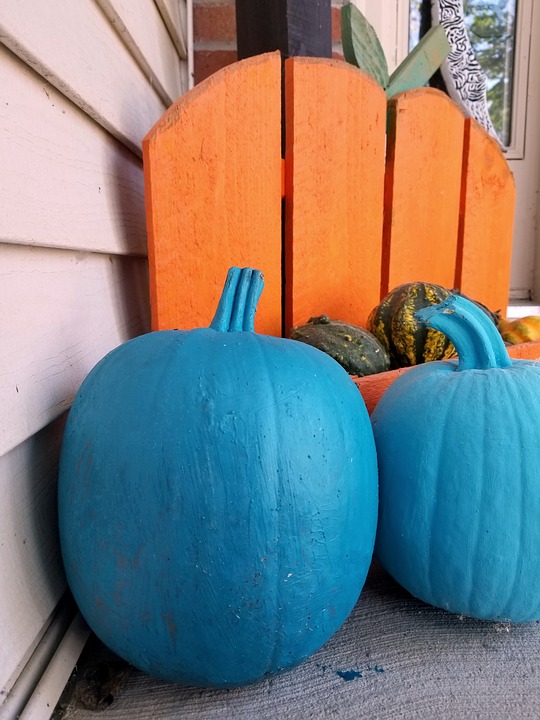While most insurance companies cover allergy testing as well as initial and follow-up visits with your allergy doctor, some of them are restrictive about the type of allergy immunotherapy that they will cover. While most will cover allergy shots (also known as...
Related Articles
Halloween is Coming. Is Your Teal Pumpkin Ready?
If you have a child who is affected by food allergies, you know that Halloween can be a challenging holiday. There are school parties with food-centered activities (think cakewalks or candy corn bingo). Those parties may be capped off with a goodie bag brimming with allergenic treats, and, of course, there’s the actual trick-or-treating where your child fills their pumpkin bucket with dozens of food items that could send them into an allergy-induced downward spiral.

(Pixabay / Jittherbug)
If someone you love has food-related allergies, they’re not alone. One in 13 children suffers from food allergies in the U.S.—that’s roughly two per school classroom. Of those children, 40 percent suffer from multiple food allergies. For these children, eating can be like traversing a minefield as they try to avoid the many foods that might trigger reactions.
One of the challenges with Halloween is that allergenic foods can be lurking in unexpected places. Candy that seems to be allergy-free may have been manufactured in plants with peanut or tree nut debris, resulting in cross-contamination. And baked goods at parties that look innocent enough may contain allergens such as wheat, milk, and eggs that can elicit symptoms.
Fortunately, there’s an increased awareness of these challenges and a solution to make Halloween better for children with food allergies through the Teal Pumpkin Project®.
How the Teal Pumpkin Project Got its Start
As a mom of a child with life-threatening allergies to peanuts, tree nuts, and cow’s milk, Becky Basalone knew first-hand the daily difficulties of navigating food allergies. She started a food allergy support group near her home in Tennessee, and for a local trunk-or-treat in 2012, she displayed a pumpkin painted teal (the color for food allergy awareness). The tradition caught on in her support group and beyond, and soon the advocacy group FARE (Food Allergy Research and Education) took the program national.
Today, the Teal Pumpkin Project is going strong as it aims to raise awareness of food allergies and promote inclusion of all trick-or-treaters throughout the Halloween season.
How to Participate in the Project
Whether or not you have a family member affected by food allergies, you can get in on the project with four simple steps:
1. Stock up on non-food treats for trick-or-treaters. This may include stickers, glow sticks, pencils, erasers, spider rings, slap bracelets, and more. These items aren’t hard to find. You can check Amazon or other online sources, Dollar Tree, or the party section of grocery and craft stores.
2. Display a teal pumpkin. Craft stores such as Michaels sell plastic teal pumpkins, but you can also paint an actual pumpkin with teal paint and set it on your front doorstep. Another option is to purchase a wooden pumpkin cut-out (or cut it yourself if you have a saw), paint it teal, and hang it on your door. Yet another option is to print a sign from the Teal Pumpkin Project website and display it prominently on your front porch or in your front yard.
3. Add your home to the Project Map. Simply visit the map site and add your location. This is also a great resource for finding project participants near you. All you have to do is plug in your zip code and a search radius, and the map will show participating homes.
4. Tell your friends. The Teal Pumpkin Project is just several years old, so there is plenty of work to do to spread the word. The more people who come on board, the more trick-or-treating options there will be for allergic kids. FARE makes it easy to get the word out with all kinds of printables, from yard signs to door signs to goodie bag labels. There’s even a “You’ve Been Booed” kit that allows you to start a chain of anonymous goodie drops on neighbors’ doorsteps, but with an allergy-free spin. There are also ideas for sharing the Teal Pumpkin initiative on social media—one of the best platforms for spreading the word.
Is There Help for Food Allergy Sufferers?
If someone you know is affected by food allergies, programs like the Teal Pumpkin Project can certainly make Halloween safer and easier, but beyond that, there’s treatment in the form of sublingual immunotherapy (SLIT). This treatment can be prescribed by a sublingual immunotherapy allergist and involves taking daily drops under the tongue. The drops contain extracts of allergenic food proteins. As your body is exposed to these proteins in gradually increasing quantities, it learns to tolerate more of the foods that you love so that eating is no longer troublesome and dangerous but enjoyable—as it should be. Contact an AllergyEasy physician to learn more.
